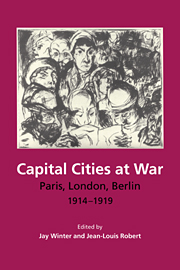Book contents
- Frontmatter
- Contents
- Note on joint authorship
- List of figures
- List of tables
- Part 1 Premises
- Part 2 The Social Relations of Sacrifice
- Part 3 The social relations of labour
- Part 4 The social relations of incomes
- Part 5 The social relations of consumption
- Part 6 Urban demography in wartime
- 14 The ‘other war’ I: protecting public health
- 15 The ‘other war’ II: setbacks in public health
- 16 Surviving the war: life expectation, illness, and mortality rates in Paris, London, and Berlin, 1914-1919
- Part 7 Towards a social history of capital cities at war
- Statistical appendix and tables
- Bibliography
- Index
16 - Surviving the war: life expectation, illness, and mortality rates in Paris, London, and Berlin, 1914-1919
Published online by Cambridge University Press: 15 December 2009
- Frontmatter
- Contents
- Note on joint authorship
- List of figures
- List of tables
- Part 1 Premises
- Part 2 The Social Relations of Sacrifice
- Part 3 The social relations of labour
- Part 4 The social relations of incomes
- Part 5 The social relations of consumption
- Part 6 Urban demography in wartime
- 14 The ‘other war’ I: protecting public health
- 15 The ‘other war’ II: setbacks in public health
- 16 Surviving the war: life expectation, illness, and mortality rates in Paris, London, and Berlin, 1914-1919
- Part 7 Towards a social history of capital cities at war
- Statistical appendix and tables
- Bibliography
- Index
Summary
Introduction
Part of the story of the well-being or ill-being of populations at war is unmistakably demographic. Rates of sickness, death-rates, life expectation at birth describe the rhythms of daily life and the contours of thousands of family histories. But in and of themselves, they do not constitute a summary measure of well-being, let alone an answer to the question as to why one side won the war and the other lost it. Our purpose in the following survey of civilian health is more modest: it is to provide additional evidence about well-being in wartime by rigorously describing its opposite.
Without a comprehensive picture of morbidity, mortality, and survival chances, it is impossible to investigate systematically what Sen has called the ‘capabilities’ and ‘functionings’ of populations. When the influenza epidemic of 1918 to 1919 struck, much of life – in and out of the armies – came to an abrupt halt. Illness reduces capabilities and functionings; ultimately to the vanishing point. By studying civilian death-rates, we can see evidence both of the successful defence as well as the progressive erosion of capabilities on the home front during the 1914-18 war.
Our findings offer a clear contrast among these three cities and a clear narrative line within which to set the comparative history of the impact of war. This is the great advantage of demographic analysis. By definition comparative, it enables us to ask the same question of roughly similar sources available for all three cities, a luxury we did not enjoy in many of the earlier chapters of this book.
- Type
- Chapter
- Information
- Capital Cities at WarParis, London, Berlin 1914–1919, pp. 487 - 524Publisher: Cambridge University PressPrint publication year: 1997
- 3
- Cited by

